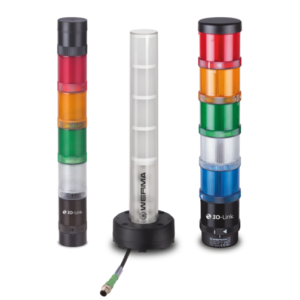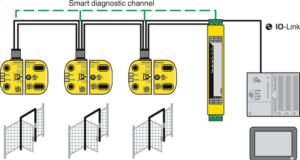New Prospects for Innovative Applications
When IO-Link got started 12 years ago, the primary goal was to be able to connect basic sensors and actuators in a straightforward way. This has gone impressively well, a fact proven by the many thousands of device types now available, among other things. The basis for this is that IO-Link reduces the types of wiring and connections to a minimum, i.e. the variety of interfaces for sensors and actuators on the one hand, as well as the automation system on the other, was reduced considerably. Sensors and actuators can also be parameterized and configured in a uniform way and provide volumes of identification and diagnostic data. This is what makes Industry 4.0 possible. In other words, Industry 4.0 would be totally in limbo without IO-Link.
A lot has happened in the market since the early days. The IO-Link communication interface has been standardized in international standard IEC 61131-9 and, with 8 million installed nodes, is a shooting star in communication technology. It isn’t just the absolute number of nodes that’s interesting, though – the acceleration is noteworthy, too. The total number of nodes rose by 47% at the beginning of 2016, and an increase of 52% was seen in 2017. Today, users can essentially choose from around 3,000 different devices with an IO-Link connection. Enthusiastic users can be found across the globe, from Europe to Japan and the rest of Asia to the US.
The fact that totally new device types which no-one would have ever conceived or thought possible at the beginning are now emerging can be attributed to three different effects.
- For one thing, the integration of IO-Link is unbeatable in terms of size and connection technology. With IO-Link, all that’s required is an area of less than 0.5 cm² and a single plug (usually M12, but M8 and even M5 can be used) – ideal requirements for very small components.
- Higher temperatures like those to which temperature sensors are exposed in process-level applications, for example, are easier to keep under control than with Ethernet-based systems.
- In addition, IO-Link is able to fully incorporate functionality and performance for many device applications with the fieldbus systems, even though IO-Link is just a point-to-point interface.
The most resounding argument, though, is its openness and worldwide acceptance. Large numbers of different interfaces no longer need to be developed, tested and certified. IO-Link decouples the fieldbus level from the sensor/actuator level. This lets manufacturers focus on just one interface, which saves time & money and creates space for new ideas.
Innovative Applications Made Easy
It’s now becoming easier to digitize devices for which a communication connection used to be technically or economically much less feasible. Examples of this include robot grippers, clamping elements and vacuum generators which are generally used in small numbers, yet come in a large variety of different versions. These devices with IO-Link can now be used anywhere in the world without the need for modification.
 Signals columns with IO-Link (e.g. from Balluff and Werma) are still showing the practical benefits IO-Link can have several years after their market introduction. Lamps such as those for displaying the fill level of boxes were previously only able to indicate full or empty. Now, the exact fill level can be displayed visually. Whereas arm-thick cables were required for displaying a variety of different conditions, now a standard cable over IO-Link is all that’s needed today.
Signals columns with IO-Link (e.g. from Balluff and Werma) are still showing the practical benefits IO-Link can have several years after their market introduction. Lamps such as those for displaying the fill level of boxes were previously only able to indicate full or empty. Now, the exact fill level can be displayed visually. Whereas arm-thick cables were required for displaying a variety of different conditions, now a standard cable over IO-Link is all that’s needed today.
Safety switches from Phoenix Contact, with their smart diagnostic channel, are able to utilize the universal connection of IO-Link for diagnostic functions as well. This is the preliminary stage to IO-Link Safety, so to speak – the next big step for IO-Link. Up until now, safety functions and IO-Link diagnostics had been initiated with separate wires. In the future, only the three wires of IO-Link will be needed here.
Another combination of safety functions and standard functions are operating panels with emergency-stop pushbuttons and controls such as buttons, lamps and displays. IO-Link simplifies cabling of the standard functions here as well. The safety function still has to be connected separately.
 With IO-Link Safety, these applications become even easier, as safety-related signals and standard information can be transmitted together over the three wires of IO-Link here. Universal usability with practically every automation system in the world is even more valuable here, as development for these types of devices can represent multiple investments.
With IO-Link Safety, these applications become even easier, as safety-related signals and standard information can be transmitted together over the three wires of IO-Link here. Universal usability with practically every automation system in the world is even more valuable here, as development for these types of devices can represent multiple investments.
Opening up New Areas of Application
Considering these features, the IO-Link community is discovering new applications all the time, and they’re far from simple sensors and actuators.
Frequency converters – including those with several kW of power – intended for use exclusively with either fieldbus or Ethernet systems, are now equipped with IO-Link. Machine manufacturers who have to supply their product to different regions of the world and therefore have to use different automation systems can retain the optimally adapted drive they already have. This also applies to hydraulic and pneumatic axes and control valves.
Other markets, like utility vehicles and process automation, are now discovering IO-Link as well. In the case of utility vehicles, the motivation is more so that traditionally connected devices of IO-Link providers were always used and that now interesting and much more powerful solutions are available with IO-Link. In addition to traditional continuous applications –which also often require explosion protection – in process automation, there are also the so-called hybrid applications where, for example, pharmacological tablets have to be produced and then packaged following a continuous chemical process. IO-Link is able to score big here, which is why it’s being used more and more in this area.
Taking Action Independently
Another aspect here is special solutions which are often specific to an individual machine. 30 years ago, many machine manufacturers developed a vast amount of electronics specifically for themselves. Then the needle swung in the opposite direction, as this was very cost-intensive and most functions could also be implemented with off-the-shelf electronics. Pressure from the competition to differentiate can’t always be alleviated with standard electronics, though. In the past, the integration of specific technical functions was very laborious. With IO-Link, it’s easy and consistent for different automation systems.
Examples of this kind of solution, which are often mechatronic as well, include specific monitoring systems and operating panels all the way to complete sub-system controllers. These can also be very small devices like specialized sensors or entire machine modules. As such, the machine manufacturer is able to bypass customer requests to implement specific automation systems (off-the-shelf electronics) for their strategically important functions. Special functions can be perfectly integrated into all higher-level systems.
Conclusion
Integrating IO-Link and using it with all its advantages is a profession. Innovations which are first inspired by IO-Link provide a real wow factor. IO-Link is simply a lot of fun!
Klaus-Peter Willems
Member, IO-Link Steering Committee
